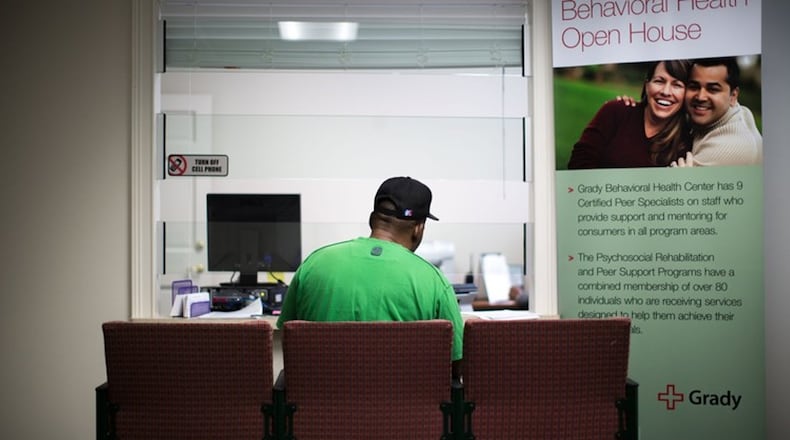The 16-year-old drew pictures that scared her mother. Angels crying tears of blood. Devils. People hanging from trees.
Then the girl attempted suicide, and her mother sought help from Georgia's community-based mental health system. But therapists never flagged the girl's risk for suicide, even after she inflicted what they recorded as another "self-injury." When she skipped several appointments, a counselor left only a single voice mail for her mother, who speaks no English.
Three days before Christmas of 2016, the girl’s family found her in the back yard. She had hanged herself on her swing set.
State regulators cited the mental health agency that handled the girl’s care, the Clayton Center Community Service Board in Jonesboro, for five “deficient practices.” They also listed five “concerns.”
But the regulators imposed no fines or other sanctions. They required only that the agency draft what they call a corrective action plan – in essence, a promise to do better.
The state took the same approach to the 34 other suicides during a recent 12-month period by people under the care of community health providers, an investigation by The Atlanta Journal-Constitution found. Officials penalized none of the publicly funded agencies, even when serious errors apparently contributed to the deaths.
The suicides, as well as the state's muted response, illustrate how Georgia continues to fall short of its promised overhaul of a mental health system long plagued by substandard care, abuse, neglect and unnecessary deaths.
The state not only does not punish mental health care providers, it lets the agencies choose their own remedies for breakdowns in treatment. In cases reviewed by the Journal-Constitution, this often involved little more than additional training for the agencies’ staffs. In a single instance, a community service board fired two employees after a patient’s suicide.
In an interview, officials with the state Department of Behavioral Health and Developmental Disabilities said they have established procedures for screening patients for suicide risk that all mental health care providers must follow. When suicides occur, said Monica Johnson, the director of the department’s mental health division, officials want to know “if something could have been done differently.”
“There is not one consistent answer to that,” she said.
The department’s commissioner, Judy Fitzgerald, said particularly egregious errors – “a persistent pattern of practice” – could jeopardize a provider’s state funding. But mental health care providers are in short supply, Fitzgerald said, and her department’s first response to a patient’s unexpected death is not to hand out punishment but to “always make sure other individuals are not at risk.”
Devon Orland, litigation director for the Georgia Advocacy Office, which represents people with mental illness and other disabilities, put it a different way.
“The state has to gamble,” she said. “Is it better to have a bad provider or no provider at all?”
‘Foolproof?’
One woman hallucinated about seeing relatives who had been dead for years. Another believed her husband and his girlfriend used satellites to implant thoughts into her mind. One paced relentlessly, mourning her late husband. At least two struggled to reconcile their sexual identities.
"Please forgive me," another man wrote to his family. "I hurt so bad. I smell like death."
All killed themselves while under the care of one of Georgia's 23 community service boards. These agencies have existed for years but have become more fundamental than ever in the mental health system. During the past decade, with the system operating under the supervision of a federal judge, the state closed two public psychiatric hospitals and reduced the number of beds in other facilities. The idea was to divert as many patients as possible from monolithic institutions to more personalized treatment in their communities.
Those providers face a “capacity issue” — more patients and not enough treatment professionals — that may undermine suicide prevention efforts, said Robyn Garrett, executive director of the Georgia Association of Community Service Boards.
“Let’s look at that,” Garrett said, “at the workforce development side of this.”
The state has only recently begun tracking suicides in community care. But the 35 deaths between July 2016 and June 2017 seem to indicate a steep increase from past years. Between 2002 and 2007, for example, just 11 patients killed themselves in the state hospitals or within a few weeks of being discharged, a fraction of the latest-available annual total.
The behavioral health department does not release the names of patients who kill themselves and redacts many details from its investigative reports. The Journal-Constitution identified about half of the recent suicides from public records and other sources, but is not naming them to protect the privacy of their families.
Among the 35, three were teenagers, as young as 16. The oldest was 71. Women outnumbered men, 19 to 16.
Regardless of age or gender, a patient’s suicide is considered the ultimate failure for any mental health program. But the people who run the community service boards say some deaths may be inevitable.
"It would be nice if they could be watched 24 hours a day, seven days a week," said Cindy Levi, chief executive of Avita Community Partners in Flowery Branch, which reported five suicides from 2016 to 2017. "Unfortunately, that's not going to happen anywhere unless they are in an institution.
“There is not a 100 percent foolproof.”
But state investigative reports and other public records detail serious errors in about two-thirds of the 35 suicides. Therapists, psychiatrists and other staff members frequently failed to assess patients’ suicide risk, as state regulations require; did not always flag warning signs of suicide in patients’ records; and allowed suicidal patients to repeatedly miss appointments – a sign of a deteriorating mental state – without checking on their wellbeing.
One of the 35 never met his therapist and spoke to his psychiatrist just once, and then only through a video link. Another missed three counseling appointments in September, three in October, two in November and three again in both December and January, with little or no intervention by therapists or physicians. When he finally returned in March, he said he had used “positive self-talk” to control his thoughts of suicide.
He killed himself six days later.
‘I am worth living’
At an Avita Community Partners clinic in Toccoa, a 40-year-old man described his suicide plan in excruciating detail.
"I wish that I would cease to exist sometimes," the man told his therapist, according to state records. "I'm tired of dealing with this pain, the self-inflicted emotional pain that I'm always in."
He had bought a rope, he said, and intended to attach it to a rafter that supported his punching bag. “I told my mom I love her and bye,” he said.
The therapist made notes on the man’s threats, along with other circumstances that elevated his risk for suicide: He had recently spent time in both a psychiatric hospital and jail and was due back in court soon. He had tried to kill himself at least three times. And he said he contemplated suicide as much as eight hours a day, every day.
The following week, though, the therapist wrote that the man had not identified “extraordinary events/stressors” that indicated he would kill himself, according to state records. The therapist “facilitated deep breathing exercise saying goodbye to old self,” the records said, and she urged him to recite a mantra: “I am worth living.”
The therapist passed the man’s file, including the suicide threat, to a psychiatrist on Avita’s staff. But the doctor never read it. He was booked with “back-to-back appointments,” state records say, and had no time to study the man’s history or his current symptoms. Such a review might have prompted the man’s admission to a crisis stabilization unit or other inpatient facility.
A little after 1:30 p.m. on Dec. 7, 2016, the man’s mother carried clean laundry to the outbuilding on her property where her son was staying, according to a coroner’s report. She found her son with a rope around his neck, hanging from the rafter that supported his punching bag.
State investigators documented a long list of problems with how Avita handled the case. The man had gone as long as five months between appointments with a therapist or his psychiatrist, and a therapist didn’t grasp the significance of the man’s planning his suicide so meticulously.
But the state made just one recommendation:
“The Avita medical director should review the management of this case with the patient’s physician.”
‘Corrective actions’
When patients take their own lives, therapists and psychiatrists go through a process of rigorous reflection, said Levi, Avita’s chief executive.
“What can we change? What happened? What improvements can be made?
"We learn from what's happened and take action to do better next time," Levi said. "We're always trying to glean something."
Still, these examinations sometimes leave unanswered questions.
On July 28, 2016, a patient told her therapist at Georgia Rehabilitation Outreach in Atlanta that she thought about suicide every day.
“I hate my life,” the woman said.
But the therapist let the woman go home alone. The woman killed herself five days later.
The therapist later told reviewers that the patient “always said she hated her life,” hoping the threat would enable her to move in with her mother. But the therapist couldn’t explain why a patient who expressed active suicidal thoughts wasn’t admitted for emergency psychiatric treatment.
“An oversight,” she suggested.
The agency’s chief executive did not respond to requests for an interview. State records show the agency fired the therapist and another employee.
Georgia Rehabilitation told state officials it would train all employees in “emergency intervention,” time management and other matters. The state responded that the agency should “identify the basic cause(s) of cited deficiencies and take corrective actions to prevent recurrence.”
In Jonesboro, the 16-year-old girl who hanged herself had been under the care of the Clayton Center for six months when she died on Dec. 22, 2016. A month later, the agency told state regulators it was researching suicide-risk training for all employees.
Two more months went by. Minutes of a board meeting in March 2017 show that the agency’s chief executive, Aundria Cheever, announced: “Regretfully, a youth … committed suicide.”
Then she told the board that the agency planned to train all employees on evaluating suicide risk among adolescents.
State officials had already completed their investigation of the agency’s role in the girl’s death. They concluded by saying they had “no additional recommendations.”
» MORE: The Invisible Epidemic: Poor and mentally ill in Georgia
About the Author
The Latest
Featured




